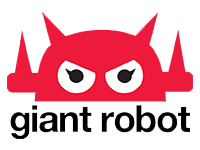Giant Robot Store and GR2 News
What follows is a brief report on the most recent of my trips to the disaster-afflicted areas in Tōhoku. Refer to my GR piece about the four trips I took to the North during the first month of the disaster.
 As I reported previously, Kazu, my brother-in-law in Onagawa, and I had devised an (admittedly vague) guerilla-style plan to distribute doner kebab, pita sandwiches, and possibly ice cream to those in need. Typically, Kazu drives his truck into Sendai and sells pita sandwiches as o-bento lunch for office workers there, and he recently augmented his truck with a Dairy Queen-type ice cream maker to entice local customers. (Though Sendai is a good-sized metropolis, Onagawa is a small fishing town, and kebab considered quite exotic there.) Obviously, the Tōhoku disaster brought business to a screeching halt. With no electricity to power the refrigeration at home, and no petrol for the truck or generator, Kazu had given away all his remaining stock to survivors the first day after the quake and tsunami, and the truck had sat idle in his backyard since. So, we envisioned, I’d re-supply him with fresh ingredients (meat, veggies, pita, yogurt, and ice cream) and he’d give away hot meals to folks living in the refugee centers. Or something like that. You hear about kids in the early days of Japan’s occupation, now in their seventies, fondly recalling the taste of chocolate and bubble gum given them by GIs; perhaps a generation of kids will grow up in Tōhoku with similar memories of their first kebab.
As I reported previously, Kazu, my brother-in-law in Onagawa, and I had devised an (admittedly vague) guerilla-style plan to distribute doner kebab, pita sandwiches, and possibly ice cream to those in need. Typically, Kazu drives his truck into Sendai and sells pita sandwiches as o-bento lunch for office workers there, and he recently augmented his truck with a Dairy Queen-type ice cream maker to entice local customers. (Though Sendai is a good-sized metropolis, Onagawa is a small fishing town, and kebab considered quite exotic there.) Obviously, the Tōhoku disaster brought business to a screeching halt. With no electricity to power the refrigeration at home, and no petrol for the truck or generator, Kazu had given away all his remaining stock to survivors the first day after the quake and tsunami, and the truck had sat idle in his backyard since. So, we envisioned, I’d re-supply him with fresh ingredients (meat, veggies, pita, yogurt, and ice cream) and he’d give away hot meals to folks living in the refugee centers. Or something like that. You hear about kids in the early days of Japan’s occupation, now in their seventies, fondly recalling the taste of chocolate and bubble gum given them by GIs; perhaps a generation of kids will grow up in Tōhoku with similar memories of their first kebab.
And, after all, who doesn’t like a good ice cream cone?
 First task: acquiring 60kg of Australian topside beef in 5mm slices, and 3kg each of minced lamb and beef. Lack of power, and brownouts in some dairy-producing parts of Japan have made yogurt scarce as well (I’d recently heard about a friend’s wife outsmarting supermarket restrictions on dairy purchases by lining up in disguise). And, then, several kilos of fresh cabbage and tomatoes. Issaku, owner of my favorite Tokyo izekaya, had the meat delivered to me on ice (no point trying to cram that much into my fridge); and Mo, a brother-in-law living in Tokyo, collected requisite yogurt and vegetables. So far, so good. I also agreed to give a ride up north to Gome, a young rapper and skateboarder whose best friend was 3rd AD on my second feature, and who’d lost touch with his family in Onagawa. During the drive north Gome would keep us alert with his hip-hop demos.
First task: acquiring 60kg of Australian topside beef in 5mm slices, and 3kg each of minced lamb and beef. Lack of power, and brownouts in some dairy-producing parts of Japan have made yogurt scarce as well (I’d recently heard about a friend’s wife outsmarting supermarket restrictions on dairy purchases by lining up in disguise). And, then, several kilos of fresh cabbage and tomatoes. Issaku, owner of my favorite Tokyo izekaya, had the meat delivered to me on ice (no point trying to cram that much into my fridge); and Mo, a brother-in-law living in Tokyo, collected requisite yogurt and vegetables. So far, so good. I also agreed to give a ride up north to Gome, a young rapper and skateboarder whose best friend was 3rd AD on my second feature, and who’d lost touch with his family in Onagawa. During the drive north Gome would keep us alert with his hip-hop demos.
 I rented a 6-seater van (called, delightfully I thought, a “Bongo“) the day before setting out and rode out to Asakusa-bashi to stock up with relief supplies at Second Harvest Japan, the food bank for which I’d already made a couple relief runs to the North. Charles McJilton, director of Second Harvest, loaded me up with about 300 bananas, 40 cases of fig cookies (donated by the French), and several boxes of canned fruit, and gave me a target: a school doubling as a refugee camp in Natori City, en route to Onagawa. But Charles also warned me that a couple drivers had recently been turned away at their destinations. Multiple governmental and non-governmental organizations are now supplying the North, but unavoidable overlap and, alternately, poor coverage in the various towns and villages affected have resulted in some points oversupplied, while others still lack the basics. Meanwhile, national and local bureaucratic controls have tightened, making it difficult for many grass-roots volunteer parties to get through. So, I told Charles, I’d stop off in Natori and see if they’d take the supplies, but if not needed there, I’d continue north and locate an alternate beneficiary in Ishinomaki or Onagawa, my ultimate destinations.
I rented a 6-seater van (called, delightfully I thought, a “Bongo“) the day before setting out and rode out to Asakusa-bashi to stock up with relief supplies at Second Harvest Japan, the food bank for which I’d already made a couple relief runs to the North. Charles McJilton, director of Second Harvest, loaded me up with about 300 bananas, 40 cases of fig cookies (donated by the French), and several boxes of canned fruit, and gave me a target: a school doubling as a refugee camp in Natori City, en route to Onagawa. But Charles also warned me that a couple drivers had recently been turned away at their destinations. Multiple governmental and non-governmental organizations are now supplying the North, but unavoidable overlap and, alternately, poor coverage in the various towns and villages affected have resulted in some points oversupplied, while others still lack the basics. Meanwhile, national and local bureaucratic controls have tightened, making it difficult for many grass-roots volunteer parties to get through. So, I told Charles, I’d stop off in Natori and see if they’d take the supplies, but if not needed there, I’d continue north and locate an alternate beneficiary in Ishinomaki or Onagawa, my ultimate destinations.
We set off from my flat at 5:30 AM on April 14th and made good time getting up into Miyagi Prefecture, stopping a few times along the way to top off the Bongo’s gas tank (but, I have to admit, blasting through Fukushima Pref. without stopping). We got off the Tōhoku Expressway for our stop in Natori, but the only official we managed to meet at our target, Natori Fujigaoka Primary School, having been newly dragooned from her usual post in Kyōto, was unfamiliar with local procedures and unable to direct us towards any appropriate facilities. We’d read some recent newspaper headline about shortages in Onagawa, so we decided to continue on, lest our cargo spoil.
Please excuse the scattershot nature of this rambling work in progress. – m
Today is the one-month anniversary of the Tohoku quake and tsunami disaster, but my flat is still rattling from aftershocks (I counted three today, but I’m sure there were more). Last weekend was actually the first I’ve spent at home in Tokyo since March 11, when the big one hit. Much of the last month I’ve been up north, looking for my in-laws, ferrying supplies to relief organizations, and being a guide for foreign television crews looking to get close to ground zero in the first days after the disaster.
The first of those trips began only a day after the initial quake. At 3:45 PM I’d received a fragmented text from a brother-in-law living up north: Fleeing. After that, it was impossible to get though to anyone in Tohoku via landline, mobile phone, or internet. But the television reports during the first hours, though incomplete or contradictory, were painting an increasingly bleak picture. Onagawa, Ishinomaki, Tagajo, Kesennuma, Minami Sanriku, all the nice little northern towns I’d visited so many times over the last ten years, were now listed as among the worst hit by the tsunami. The extent of damage to the Fukushima and Onagawa nuclear plants was as yet unclear, but I remembered years ago joking with my Onagawa in-laws about the disaster warning intercom installed in their kitchen. This little box would periodically sound a test alarm, like the radio broadcasts I grew up hearing: “This is a test of the Emergency Broadcast System…” (perhaps, given the Japanese context, more like an air-raid warning).
I got the call from Christian Storms (real name) around midnight. A crew from Channel 7 Australia needed a “fixer” for a trip to Tohoku. A fixer’s job typically involves interpreting and translating, driving and navigating, arranging interviews, and securing official clearance to shoot. Not my usual gig, but Christian knew I had family in the affected areas and thought I might be a good fit for the Aussie expedition. Twelve hours later, having bluffed our way through the police barricade at the Tohoku Expressway onramp, the four fellows from Channel 7 and I were driving northbound in Christian’s eight-seater Toyota HiAce van.
I had a vague plan to make a stop at the house of one of my brothers-in-law, in Tagajo, a Sendai suburb, and drop off a Hefty bag of hastily gathered (in retrospect, quite useless) supplies. But our real goal was to get north of Fukushima Prefecture, and up into Miyagi’s Oshika Peninsula, where some of the worst tsunami damage had been reported. We’d been told of an Urban Search and Rescue (USAR) team that had flown in on a military transport from New South Wales, and hoped to track them down and deploy with them, but we really didn’t know where we’d end up or what we’d find.
Over the next three days, I guided the Aussies from one wrecked seaside town to another, stopping to pick up interviews or shoot an on-camera report, making detours to visit local refugee centers and ask about my in-laws, scrounge gasoline, and sleep on floors. My notes of the trip read like passages from the Divine Comedy, where Dante leads Virgil through the nine circles of hell. (I think the Taoists give hell eighteen layers, but who’s counting?)
 The absolute nadir of this first trip has to have been our walk through Minami Sanriku with the USAR team. Our point of entry was about 10 kilometers from the coast, at the back of the narrow valley leading down to Shizukawa Port. We could see how the tsunami had hit the port and then been funneled up into this gorge, taking everything with it. It was like the entire town had been put in a Cuisinart. A snapshot I took during our first walk clearly shows a baseball bat, a fiberglass dinghy, an ice cream vending machine, a small tractor, a Western-style toilet, photo albums, bicycles, cars, trucks, children’s toys, a tool shed, a row of sinks, a water boiler, propane tanks, the roof of a house, a construction crane, and an entire daycare center, all in the same frame. Shredded, compacted, disintegrated, deconstructed, like someone had emptied out a child’s toy box onto the floor and then gone at the toys with a sledgehammer. And then there was everything that wasn’t visible in the picture: fourteen children (smashed into a corner of the daycare center), dead animals, gasoline, heating oil, raw sewage. Then it started snowing, snowing hard, further diminishing any trapped victims’ chances of survival (as if anyone could have survived submersion in sea water and two nights in the freezing cold). The Channel 7 report from Ishinomaki and Minami Sanriku is a pretty disturbing look at what the rescue team was up against.
The absolute nadir of this first trip has to have been our walk through Minami Sanriku with the USAR team. Our point of entry was about 10 kilometers from the coast, at the back of the narrow valley leading down to Shizukawa Port. We could see how the tsunami had hit the port and then been funneled up into this gorge, taking everything with it. It was like the entire town had been put in a Cuisinart. A snapshot I took during our first walk clearly shows a baseball bat, a fiberglass dinghy, an ice cream vending machine, a small tractor, a Western-style toilet, photo albums, bicycles, cars, trucks, children’s toys, a tool shed, a row of sinks, a water boiler, propane tanks, the roof of a house, a construction crane, and an entire daycare center, all in the same frame. Shredded, compacted, disintegrated, deconstructed, like someone had emptied out a child’s toy box onto the floor and then gone at the toys with a sledgehammer. And then there was everything that wasn’t visible in the picture: fourteen children (smashed into a corner of the daycare center), dead animals, gasoline, heating oil, raw sewage. Then it started snowing, snowing hard, further diminishing any trapped victims’ chances of survival (as if anyone could have survived submersion in sea water and two nights in the freezing cold). The Channel 7 report from Ishinomaki and Minami Sanriku is a pretty disturbing look at what the rescue team was up against.
We returned to Tokyo, all of us affected by the horrors we’d seen, but also deeply moved by our encounters with the people we spoke with: mothers who’d lost infants, orphaned children, people with nothing left but what they’d gathered onto their blanket on the high-school gymnasium floor (at one refugee center we visited). The Aussies had been to Christchurch, and I’d seen news reports from St. Bernard Parish after Hurricane Katrina; we all had notions of the destruction we’d see. But nothing prepared us for the stoic grace and quietly composed forbearance of the survivors. I’d found all my in-laws and, though they were undeniably pleased to see a familiar face, they were also standing fast, intent on sticking together and staying put, and refusing offers of refuge in Tokyo.
What a shock it was to return to Tokyo, where everything seemed business as usual, if not just a bit subdued and less well-lit. (It seemed downright peaceful compared to where we’d just been.) The Aussies made their uplink the first night back in Tokyo, and the next day I drove them to Narita for the trip home to Sydney. I have to admit to being mortified by the sight of all the expats lining up to get flights out of Japan. The number of surfboards visible in the queues suggested an early Spring Break for some. Christian said he saw two guys in a fist fight over the last seat on a Tehran-bound flight.







